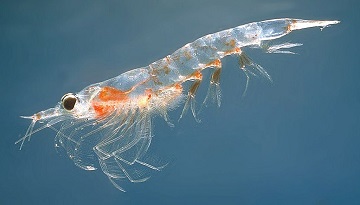SATS-199- super light detecting skill of krill- website.jpg

Krill can sense tiny amounts of light, even in dark, polar winters. Credit: Øystein Paulsen - MAR-ECO, CC BY-SA 3.0
The human body relies on sunlight to synchronize its internal clock. Light controls the release of hormones that tell our bodies whether it’s time to be alert or time to sleep—despite most of us needing an alarm clock to wake up. Most other animals, even those that are nocturnal, use sunlight to maintain their internal clocks as well. But animals living close to either of Earth’s poles need a different strategy during the long months of winter when there’s hardly any sunlight at all.
Those animals include Arctic krill, tiny crustaceans that resemble shrimp and are a staple in the diets of whales and many other sea creatures. Scientists tracked krill’s daily activity during winter using underwater recorders that detect the sounds that occur when krill move in large groups. Every night, krill swam to the surface to feed. By midday, the krill had returned to the depths where predators were less likely to find them. How did they know when to rise and dive when daytime was barely brighter than nighttime?
It turns out even the faint sunlight permeating those dark days is enough for Arctic krill to keep their internal clocks moving smoothly. Scientists measured krill’s visual sensitivity in the lab and found that they can sense more subtle shifts in available light at night than during the day, almost like reverse night blindness. The krill can perceive even tiny changes in brightness during twilight—whether from the sun, the moon or aurora borealis. They use this skill to safely continue feeding, resting, and evading predators, based on their biological clocks, even with almost no light, ensuring they never need an alarm clock


